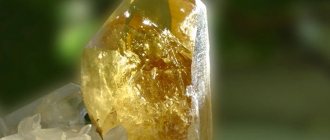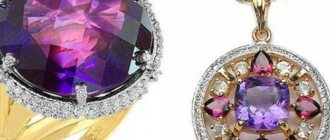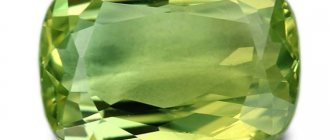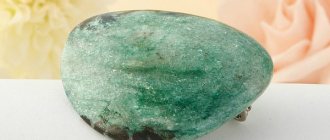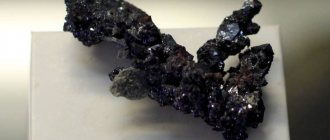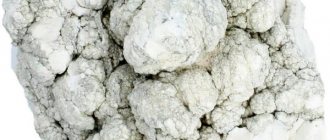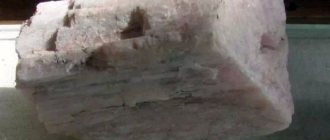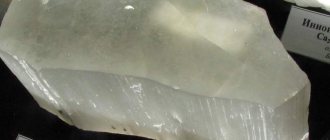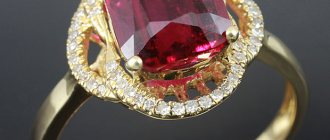Alexandrite is a mysterious, mysterious stone that was discovered quite recently. It is not for nothing that this mineral was named after the king, so it is associated with wealth, power, nobility, and is also a first-order stone.
Story
Even in ancient times, humanity was familiar with this precious stone. In the ancient Indian epic "Mahabharata" it (or ordinary chrysoberyl) was called the "peacock's eye".
There are two approximately equal in probability versions of the discovery of alexandrite.
Nils Nordenskiöld, a Finnish mineralogist, discovered a strange stone in the Ural Mountains in 1834. At first he thought that this was a suspiciously strong emerald of not the first purity, but in the light of the lamp the green gem turned into a crimson “ruby”. Soon the scientist named the amazing find in honor of Alexander II, who at that time was celebrating his coming of age (at that time, from the age of 16 a person was considered an adult).
There is another discoverer - Yakov Kokovin, who sent a sample of emerald found in 1833 to St. Petersburg. The Minister of Appanages, Lev Perovsky, took up the study of the specimen, and later gave the unusual find to the future Emperor Alexander II as a gift for his coming of age. As a result, the stone named after the tsar became his personal talisman, and, perhaps, it was he who protected him in difficult times for Russia.
In the Russian Empire, the stone was highly valued and worn only by noble people (green and red are the traditional colors of the nobility), so it was more expensive than some diamonds. Only after the First World War did alexandrite gain fame as a “widow’s stone”, because it was owned by noblewomen whose husbands did not return from the battlefield. Alexandrite then began to be associated with pain and loss.
Since the announcement of the discovery of the stone in 1842, alexandrite has long been called the “original Russian stone,” but towards the end of the 20th century, after the discovery of new foreign deposits, the mineral ceased to have a patriotic connotation.
MORPHOLOGY
Alexandrite crystals have a thick-tabular, sometimes short-prismatic appearance and are characterized by a combination of pinacoids (100) and (010), as well as prisms (011) and (120). Sometimes they are joined by bipyramid faces (111). Typical for alexandrite is the development of regular intergrowths along the prism (031), consisting of three individuals that mutually grow each other. The planes (100) merge into one, and only the direction of shading on these planes makes it possible to distinguish areas belonging to individual individuals. Twin intergrowths are better defined when the bipyramid planes (121) form reentrant angles; if these planes are absent (which is more common), the intergrowth resembles a single hexagonal crystal.
Production
The first and one of the largest deposits of alexandrite is the Malyshevskoye deposit, located in the Ural Mountains. In addition, this mineral is mined in Sri Lanka, Madagascar, India and Tanzania. Brazil also used to have a deposit, but it was soon depleted.
Alexandrite is a rare gem. Even in the large Malyshevsky deposit, among the tons of processed rock there is only one hundred grams of the mineral. For this reason, the “imperial stone” is very expensive, and not everyone can afford it.
Magic force
The Imperial Stone is a talisman of strong, strong-willed individuals. A person of weak spirit is not recommended to wear such an amulet, because not everyone can withstand the tests sent by the mineral. To those who can, the nugget will bestow support and gifts of fate at the finish line of all obstacles.
The magical abilities of the mineral are ambiguous, as are its names. Alexandrite is a prophet and communicator with other worlds. Therefore, the mineral is used during meditation for the purpose of astral travel.
But only evil can prophesy a stone. Alexandrite will definitely warn the owner of the danger, changing its green tint during the day to the scarlet color typical of the evening. It is believed that the nugget thereby warns the owner of injuries or illnesses associated with bleeding. In a life-threatening situation, the mineral turns yellow.
On the other hand, alexandrite is considered a stone of good fortune and luck, which makes it the best friend of adventurers, regardless of the type of activity. Therefore, sailors, military personnel, businessmen, lawyers and, of course, players simply need to have such a talisman. The gem is suitable for people of art - the stone will give them inspiration, and will also reveal the talents of those in whom they have been sleeping until now.
Also read: Grandidierite is a trichroic stone
But those whose life is a quiet haven do not need alexandrite. The mineral will disrupt the calm of a quiet life, introducing into it a storm of passions, risk and danger. For girls, the gem will become a source of attractiveness and the key to success in love.
Features of the mineral
Alexandrite (chemical formula – Al2BeO4) is a type of chrysoberyl with an admixture of chromium.
Chrysoberyl, despite its name, is not a type of beryl, which includes aquamarine, emerald, morganite and others. The famous feature of the “widow’s stone” is pleochroism (from the ancient Greek “many colors”). An unusual stone, like a chameleon, changes its color: green under sunlight, purple or red under electric light. Other minerals (aquamarine, tourmaline, zircon) also have pleochroism, but it is in alexandrite that this quality is most clearly expressed. This feature is explained by the presence of chromium, the atoms of which are “sewn” into the structure of the mineral.
The amazing properties of the alexandrite stone do not end with the color reverse:
- Hardness 8.5 on the Mohs scale;
- Glass shine;
- The stone can be transparent or translucent;
- The fracture is conchoidal;
- Cleavage is imperfect;
- Density 3.5-3.84 g/cm3.
STRUCTURE
Alexandrite is a biaxial crystal of orthorhombic symmetry with lattice parameters a = 0.9404 nm, b = 0.5476 nm, c = 0.4427 nm. Space group D2h, point group - mmm. Rhombic syngony. The crystal structure of alexandrite is the same as that of chrysoberyl, in which oxygen ions form a dense hexagonal packing; in the voids of the packaging, beryllium ions are in quadruple coordination of oxygen ions, aluminum ions are in sixfold coordination.
Stone color variations
Alexandrite is unique in its ability to change color. Under the rays of the sun, the mineral takes on green, olive or bluish shades, and under artificial lighting it turns into a pink, purple or red stone. Under some other lamps, alexandrite even turns yellow.
There are three varieties of alexandrite:
- Ural stones are the highest quality stones with the most clearly defined pleochroism;
- African and Brazilian - duller with a less pronounced color reverse effect;
- From the island of Sri Lanka - unique alexandrites with opalescence and a “cat’s eye” effect.
Colors and varieties
Without knowing what this “chameleon” is, it is very easy to stumble upon a fake. Before buying products with alexandrite, understand what distinctive properties it has:
- the color of alexandrite in daylight ranges from blue to green shades;
- when in a room where lamps are turned on or candles are lit, the gem changes its color to a blood-crimson color.
This is general information to help distinguish an artificial alexandrite stone from a real one. But it is a mineral found in several varieties. Each of them has its own differences depending on the deposit.
Natural Ural stone alexandrite
For example:
- The Ural species is recognized as the mineral with the most beautiful color palette. In artificial light it appears purple or violet.
- Brazilian. It has smoother transitions between colors compared to the bright contrasts of the Ural mineral.
- The Indian gem plays green-blue hues in daytime color.
- The color of stone mined in Sri Lanka appears duller in sunlight and has a brownish tint.
Properties
Magical
Alexandrite is a stone of people who love to change their lives and put it at risk. It attracts good luck, prosperity in love affairs, and inspiration. The stone lifts the mood, enhances the owner’s emotions, and increases creativity. The "Widow's Stone" is associated with the other world and has the ability to predict the future. If your jewelry suddenly turns red in daylight, this indicates that the owner will experience something related to blood loss, injury or injury. If alexandrite takes on a golden hue, then it warns of a dangerous life situation.
Alexandrite brings its owner a stormy life and risk, so only a strong person who knows how to control himself will receive a reward after all the trials. This stone is not suitable for peaceful, quiet, calm people who do not like change.
Healing
The main “specialization” of alexandrite is the circulatory system. The main colors of alexandrite - green and red - symbolize two types of blood - venous and arterial. This stone strengthens the walls of blood vessels, maintains normal heartbeat and blood pressure, treats diseases of the blood vessels, and prevents the formation of blood clots.
Alexandrite also improves the functioning of the gastrointestinal tract and calms the nervous system. Water infused with alexandrite also helps treat alcoholism, dulling the craving for alcohol.
Alexandrite is best worn during the day, and at night the gem should rest.
When to wear
Jewelry containing the original stone can be worn by women of any age. By the way, it is not prohibited for representatives of the stronger half of humanity, but it is rarely included in jewelry for men.
In most cases, products are worn for high-profile, large events and private parties. In everyday life it is appropriate only if a strict business style is observed.
The color of brown and green eyes is especially well shaded, so alexandrite is recommended primarily for representatives of this color type.
It will not become a provocative element - small sizes never look vulgar and only add a special zest to a woman’s image.
Based on these characteristics, jewelers advise choosing it solely based on appearance, color and, most importantly, budget.
Stone and zodiac circle
Alexandrite is a stone of the water element, with its iridescence personifying the impermanence of the forms of water. It is ruled by Saturn and is recommended for anyone who is willing to take risks and achieve more out of life. The stone brings good luck, inspiration, creative powers to most zodiac signs; even the quiet Pisces will be favored by the stone.
It is not recommended to wear it only for Cancers, Virgos and Taurus, because not every representative of such a sign will withstand the changes caused by the stone. Sagittarius and Aries need to wear alexandrite with caution, as it can make the energy of these signs wild and untamed.
When purchasing alexandrite, it is important to focus on your own feelings. If it suits your horoscope, but something inside is against it, then it’s better not to buy it.
Name compatibility
A strong stone is a reliable patron of a strong name. Alexandrite – suitable for names:
- Alexandra. Alexandra's unbalanced character and frequent mood swings need to be pacified. The gem will calm, balance in moments of temper and cheer up when despondency overtakes.
- Alexander. The stone affects the owner’s emotional background in the same way as it does Alexandra. In addition, the talisman will attract good luck, financial well-being to the owner, and will help to be open in relationships. The nugget will protect against stress, and in case of danger to physical or psychological health, it will change color.
- Lyudmila. She is characterized by excessive emotionality, which often leads to the wrong hasty actions. The amulet will calm the storm of emotions, removing obstacles in Lyudmila’s life path. And the change in color of the mineral will warn her of dangers.
Alexandrite is suitable for anyone who feels the strength to withstand its energy. Zodiac affiliation plays a significant role.
How to distinguish from a fake
It is logical to assume that the magical and healing abilities of the stone will only work if the stone is real and not counterfeit. Due to the fact that alexandrite is rarely found in nature, imitations made from garnet, corundum or simple glass can often be sold on the market for huge sums of money. There is nothing wrong with these minerals (except glass), but if alexandrite is what you need, then it is better to avoid unnecessary disappointment and expense.
In fact, it is quite difficult to determine which stone is real, so it is better to check it in the laboratory and ask a specialist for help. You shouldn’t order a stone online yet, because it’s difficult to identify an alexandrite stone from just one photo.
The main signs of a counterfeit stone:
- The size is too large, because specimens with a diameter of 6 millimeters are extremely rare;
- The seller does not have a certificate of authenticity of the gem;
- There are very few antique jewelry, so if you are offered “antique” jewelry with alexandrite, you should be wary;
- The glass fake does not have the effect of pleochroism, it just sparkles with an iridescent sheen, and also does not have the strength characteristic of alexandrite;
- A synthetic crystal will have crystal transparency and spherical bubbles inside (in alexandrite they have the shape of drops);
- If alexandrite turns yellow rather than red under artificial light, then it is artificial corundum;
- Andalusite also has pleochroism, but under a certain view a rainbow shine appears, which is absent in a real stone;
- Imitation spinel under artificial light will turn purple rather than red.
Astrological compatibility
Not all signs of the zodiac circle can wear alexandrite talismans. The gem is best suited:
(“+++” – the stone fits perfectly, “+” – can be worn, “-” – is strictly contraindicated):
| Zodiac sign | Compatibility |
| Aries | + |
| Taurus | — |
| Twins | +++ |
| Cancer | — |
| a lion | +++ |
| Virgo | — |
| Scales | + |
| Scorpion | +++ |
| Sagittarius | + |
| Capricorn | + |
| Aquarius | +++ |
| Fish | + |
- Aquarius. The mineral will greatly enhance the intuition and creativity of this sign.
- Leos. The royal gem is perfectly suited to the royal constellation, attracting success and power.
- Gemini. Alexandrite will pacify the inconstancy and craving of Gemini in different directions on the path of life, giving internal balance.
- Scorpios. Fighters by nature, they need a talisman that supports their spiritual aspirations to overcome all obstacles.
- For Aries, the stone will give protection and good luck in any endeavor.
- Sagittarians need self-confidence.
- Pisces. Luck will follow you through life.
- For Capricorns, the stone will help improve their financial situation, as well as strengthen their intuitive thinking.
- For Libra, the mineral will help reveal creative inclinations and give good luck in business.
And only Virgos, Taurus and Cancers do not recommend wearing a gem, since the character traits of these signs are not able to withstand the tests prepared by the gem.
Astrologers also recommend, first of all, focusing on internal sensations when in contact with alexandrite. It happens that a mineral is suitable for all parameters and compatibility, but in fact causes internal discomfort. Then it is better to refuse it, choosing another talisman for yourself.
Application
Alexandrite, unlike the universal diamond, is used only in jewelry. The price of alexandrite stone is high, since the mineral is very rare. There are few large specimens, so you can hardly see stones larger than one carat in jewelry. Imperial gems are most often set in gold or platinum; silver is not used for this stone.
The most common cut is brilliant (57 facets); Ceylon alexandrites with a “cat’s eye” effect are cut in cabochons.
Note
Alexandrite contains an inner strength that can attract difficulties and at the same time resist them. Due to its rarity and high cost, not everyone can afford to feel the support of this unusual mineral. Those who have such an honor are very lucky, because having a persistent character and strong will, you can enlist the support of the imperial nugget from the Urals.
Photo gallery of stone
5 / 5 ( 1 voice )
Care and wearing rules
There is a belief that the “widow’s stone” is a purely male gem, and it will only bring misfortune to women. However, a representative of the fair sex can prevent the bad influence of the stone by purchasing it in pairs (earrings, ring + pendant set, etc.) or with a diamond as a neighbor.
The stone is durable enough to be worn all day, but it should not be exposed to chemicals when, for example, doing household chores. It should also be stored in a separate suede or flannel bag, and not placed with other jewelry, since alexandrite, having accumulated negative energy during the day, can “share” it with other gems.
Alexandrite should be washed with warm water and soap, dirt and dust should be removed with a soft brush, and wiped with a soft cloth after washing.
Use in jewelry
Since chrysoberyl is quite expensive, you won’t see massive products with this nugget - simply no one will buy them and they are not put into mass production. Perhaps larger elements are used in custom-made individual jewelry.
From what can be found in jewelry stores, earrings and rings are often found. Also used in pendants, but usually combined with other stones.
If worn in combination with the right jewelry, it will have a beneficial effect on its owner.
Here are the selection recommendations that jewelers give:
- the most stylish combination is with gold;
- You can enhance the visual qualities of the product by combining it with amethyst, garnet, topaz, citrine, diamond - they will not spoil it at all, but will only emphasize the uniqueness;
- from the point of view of lithotherapy, it is optimal for people with problems of the cardiovascular system to wear it in a ring or a ring, as well as in a pendant (at the level of the heart).
When combining with other nuggets, there is an unspoken rule - put on alexandrite first and take off last.
Neighborhood with other stones
Alexandrite is an “imperial” stone, so it only likes proximity to expensive stones. This is that rare stone of the water element that gets along well with the most fiery gems - ruby and diamond, but does not recognize other fire minerals. It pairs well with other aquatic gemstones (especially emerald or pearl). Alexandrite can also coexist with earth gems, but only with the most expensive of them (turquoise, the best specimens of chalcedony, onyx and jasper, jadeite). The "Widow's Stone" is not worn with all air stones.
Alexandrite – properties, who is suitable for it, deposits
Alexandrite is a very rare variety of the yellow-green mineral chrysoberyl, from which it differs in its unique ability to change color depending on the lighting: under natural light it is green, under an electric lamp it is almost red.
The discovery of the stone belongs to N. Nordenskiöld, a Finnish researcher who studied the Ural emerald mines in the 19th century. When the gem first caught his eye in 1833, it was an emerald hue, but in the light of a night candle it turned out to be deep red, which greatly amazed the mineralogist. The find was named Alexandrite in honor of Alexander II, the son of the then reigning Emperor Nicholas II.
Druse of alexandrites, 3740 carats
Large specimens of alexandrite are extremely rare in nature, as are pure small specimens of jewelry quality - this makes the mineral extremely expensive. The largest known nugget was found in the Urals in the 19th century; its weight was 532 carats. This alexandrite had to be divided into several parts, since it was not possible to sell it due to the incredibly high price. The largest gem known today weighs 66 carats.
There are also earlier mentions of alexandrite in history, for example, in the Mahabharata, an ancient Indian treatise. The stone was also discovered in a 12th-century burial belonging to a Polovtsian khan - he had a ring with this amazing “chameleon” on his hand.
Place of Birth
The primary deposit of alexandrites is located in the Urals, but it was quickly depleted, although it is the Ural stones that are considered the standard - they are distinguished by a pure emerald hue in daylight and turn red in artificial light.
Today, alexandrites are mined from placers in Sri Lanka, Brazil, Kenya, Tasmania, Zimbabwe, the USA, and Madagascar. But most of the gems found there, although they are “chameleons,” are not as beautiful in daylight as the Ural stones.
It is interesting that in the Urals alexandrites were always mined together with emeralds, but the miners had a strange superstition about them. Allegedly, if alexandrite was found during excavations, then emeralds would no longer be found, so they tried to ignore the stones, not pick them up or lift them.
Varieties and properties of alexandrite
Formula: Al2BeO4
Color: blue-green, blue-green, olive green, red-violet, purple, pink-raspberry
Hardness: 8.5
Density: 3.5–3.84 g/cm3
Transparency: translucent, transparent
Cleavage: imperfect
Fracture: conchoidal
The most valuable property of alexandrite is its so-called “Alexandrite effect”, which ensures the variability of the color of the stone under different lighting conditions. It is due to the special structure of the crystal lattice of the gem and the specific arrangement of chromium impurities. There are specimens of this mineral that have opalescence, that is, they can scatter light in such a way that a glare in the form of a “cat’s eye” is formed on the surface.
Stone color in artificial and daylight
Depending on the place of extraction, the following varieties of alexandrite are distinguished:
- Ural is the best example of color change; it has the deepest and most saturated shades. In daylight it is rich green, in artificial light it is purple.
- African, Brazilian - green stone with a brown undertone during the day and red in the light of a night lamp.
- Indian and Sri Lankan - under different types of lighting it is bluish-green, pinkish or red.
Who is alexandrite suitable for?
On the Internet you can often find references to the fact that alexandrite is considered a widow’s stone. The prerequisites for the emergence of such a sign can be found in the history of our country. The fact is that fashion for it returned in the post-war years, when many men did not return from the front, so they began to say that the gem brings misfortune. But such beliefs are not relevant in the modern world, where alexandrite has been worn by successful people for many years, and the stone costs quite a lot, because there is a huge demand for it.
Alexandrite is a stone that brings good luck. It is useful for athletes, players, and businessmen. It also helps to get to know people better, promotes mutual understanding - it can be worn by diplomats and anyone who has to communicate a lot and interact with other people and communities.
If we talk about the compatibility of a gem with zodiac signs, then it is worth mentioning its beneficial effect on representatives of the water element. It is less suitable for fire signs, with the exception of lions, for whom it will help achieve their ambitious goals.
Alexandrite also has a number of healing properties, especially in relation to blood vessels - it helps get rid of blood clots, normalize heart function and eliminate varicose veins. This gem also has magical powers. It is believed that if a stone changes its color to red in broad daylight, this means danger is approaching. Alexandrite also serves as a conductor between worlds, therefore, it is useful during meditation, and can also give inspiration to creative people.
Differences from fake or artificial
It is extremely difficult for a non-professional to find the difference between alexandrite and a fake. Experts use a refractometer and a spectroscope to test these stones.
You can distinguish natural stone from synthetics by color: the first shimmers with green-red colors, and the second changes from blue-gray to pink. In the 70s, that is, back in the days of the USSR, laboratory alexandrites were actively produced in Russia, which in artificial light took on the color of amethyst, and in sunlight - violet and blue. Today, such stones continue to exist in circulation and many sellers are not even aware of their true nature.
Green andalusite is very similar to alexandrite, it is even capable of pleochroism, but it makes no sense to pass off one gem after another - both are almost equally rare. But they may well try to sell spinel and corundum under the guise of a “chameleon” if their samples have an alexandrite-like effect.
Andalusite
Stone care
Alexandrite does not have any specific care requirements, but it is necessary to follow the standard rules typical for any colored stones.
- Protect the stone from temperature changes: do not store near heating devices, do not wear in cold weather.
- Avoid direct exposure to sunlight.
- Remove jewelry with alexandrite when cleaning and washing dishes to avoid contact with household chemicals.
- Rinse the stone with warm water and wipe with an optical cloth.
If your jewelry needs serious cleaning, it is better to turn to professionals. You can find out more about the rules for caring for jewelry in our special article.
The cost of alexandrite and its use in jewelry
Jewelry with alexandrites is a priori exclusive and is available only to a few. These stones belong to the first category of precious stones and can cost more than diamonds and rubies: from $6,000 to $20,000 per carat, artificial samples are valued at up to $500 per carat.
The vast majority of alexandrites never become part of jewelry, but are sold at auctions in the form of stones to private collectors, because these nuggets are valuable in themselves. For this reason, it is almost impossible to buy products with alexandrite in our country, but in the Maxim Demidov catalog you will find rings with alexandrite and earrings. In the near future, our jewelry house will present a new collection with this unique mineral.
Artificial alexandrite
Throughout the 20th century, attempts were made to develop a synthetic analogue of alexandrite, since the natural gem is too rare and expensive. Success was achieved by chemists from the Novosibirsk Academgorodok, who learned to grow crystals of an artificial mineral up to 12 centimeters in length. Experiments were carried out using the Czochralski method at a temperature of 2500 degrees Kelvin, as a result of which the crystal was stretched.
Back in Soviet times, natural alexandrite was replaced on the market by artificial corundums grown in such a way that they eventually acquired the ability to change color like a real “widow’s stone.” This imitation was much cheaper than natural alexandrite.
Products and jewelry made of alexandrite
Alexandrite jewelry
Alexandrite is a first-order mineral, that is, the most expensive. Fellow “caste” stones are rubies, diamonds, emeralds and sapphires. The price of one carat of the purest alexandrite can reach 1 million US dollars. Individual pieces are valued at more than similar diamonds.
Today, jewelers offer jewelry with natural or artificial stone. It is worth noting that an artificial mineral is inferior to a natural one only in price, but in properties, appearance and degree of pleochroism it sometimes surpasses a natural gem. Naturally, the synthetic analogue has neither magical nor healing abilities.
So, pure, flawless alexandrite can most likely be found only in private collections, or you can order custom-made jewelry. Both will cost exorbitant amounts of money. On the shelves of jewelry stores you can find either artificial minerals or natural ones, but of lower quality (insignificant reverse indicator, turbidity). The prices of both options are comparable.
Jewelry with natural alexandrite is made from gold or platinum. In addition to these metals, synthetic stones are also set in silver. Starting price for a product with an artificial gem:
- Gold earrings – from $500.
- Ring – from $300.
Silver products are cheaper. But products with natural stone of the highest category are purchased at auctions for millions of dollars.
